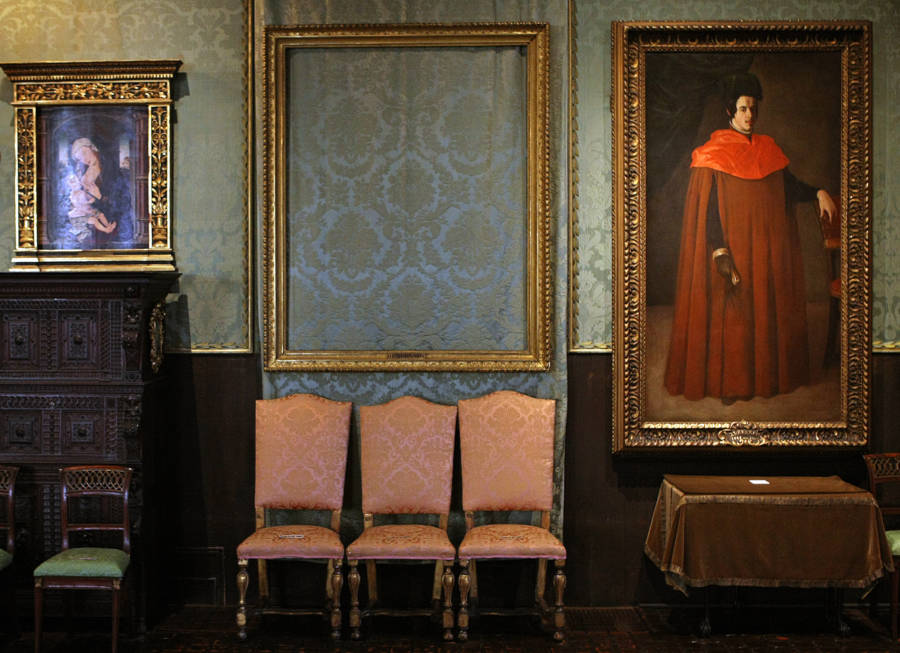The Isabella Stewart Gardner Museum heist remains the largest private property theft in American history — and its last surviving link has just slipped through the authorities' fingers.

David L Ryan/The Boston Globe via Getty ImagesAn empty frame where Rembrandt’s The Storm on the Sea of Galilee, circa 1633, once was.
On March 18, 1990, two thieves disguised as policemen broke into a Boston art museum, tied up a guard, and stole 13 paintings right off the walls. The infamous Isabella Stewart Gardner Museum heist has since been hailed one of the most devastating thefts of private property in art history.
Decades later, $500 million worth of masterpieces — Rembrandts, Vermeers, and sketches by Degas — are still missing. In the aftermath of the heist, authorities considered a complex web of suspects, but the investigation ultimately failed to pin the crime on anyone in particular.
Now, the last alleged and surviving link to the Isabella Stewart Gardner Museum heist, the now-fragile and geriatric mobster Robert Gentile, has been released from prison. And with Gentile now free, perhaps this case may never be resolved.
The Isabella Stewart Gardner Museum Heist
Around midnight on March 18, 1990, a Dodge Daytona pulled up to the side entrance of the Gardner Museum. Nearly an hour later, two men emerged from the vehicle in fake police uniforms demanding entry into the museum to investigate a noise complaint they received.
Security guard Richard Abath buzzed the thieves in and was promptly placed under a fake arrest. Believing the arrest to be real, though a misunderstanding, Abath quickly realized that one of the policemen’s mustaches was made out of wax. Abath and a second security guard on duty were bound and brought into the Gardner Museum’s basement where they were informed that they weren’t under arrest but rather victims of a robbery.

Wikimedia CommonsManet’s Chez Tortoni, a masterwork stolen during the heist.
The thieves proceeded to remove priceless works right from the museum’s walls. They then cut Rembrandt’s The Storm on the Sea of Galilee, and A Lady and Gentleman in Black as well as Vermeer’s The Concert and Govaert Flinck’s Landscape with Obelisk out of their frames. The thieves also snatched a Chinese bronze vessel from the Shang dynasty, Manet’s Chez Tortoni, and five Degas drawings. After unsuccessfully attempting to unscrew a Napoleonic flag from the wall, they took the eagle finial atop it instead.
The thieves then brought these Gardner Museum works out to their car in two trips. Police did not arrive to investigate and release the guards until 8:15 a.m. the next morning.
In a matter of 81 minutes, $500 million worth of art was stolen in the Gardner Museum heist — and nearly 30 years later, remains so.
The Investigation And Suspects
For starters, investigators felt the thieves probably didn’t know too much about art. The museum’s most expensive piece, a painting by Titian, remained untouched in its gallery.
But although the thieves may haven’t been too sharp in this respect, they were good enough to leave authorities baffled. Basements and attics from coast to coast were searched, but nothing was found.
Leads have gone hot and cold since 1990, though in more recent years, the FBI has zeroed in on a local band of thieves — many now dead — with ties to Mafia families in New England and Philadelphia, including to mafioso Whitey Bulger.
“If these paintings do not get recovered — and I hope that’s not the case — it’s not going to be for lack of trying by the FBI, the museum, and the US attorney’s office,” said FBI Special Agent Geoff Kelly, a 12-year leader of the investigation.

David L Ryan/The Boston Globe via Getty ImagesSpaces for missing Rembrandt paintings. The work was cut from the frames.
Eventually, the FBI believed they had traced the art to a location either somewhere in Connecticut or Philadelphia and offered a reward for more information — first $1 million, then $5 million, and ultimately $10 million.
In 2013, authorities were quite confident about the identity of the thieves but did not reveal them as they are believed to be deceased. Besides, the statute of limitations for the Gardner heist expired in 1995.
At this point, the enduring investigation has less to do with incarceration and everything to do with retrieving the missing masterpieces. That said, anyone found in connection to the Gardner heist or loss of the works could still face some charges.
The Release Of Robert Gentile And The Future Of The Case

Cloe Poisson/Hartford Courant/TNS via Getty ImagesRobert Gentile
One such character the police have focused on over the years is a used-car salesman and petty criminal named Robert Gentile. Gentile was incarcerated in 2018 for 54 months on weapons charges. He alleges the charges were fabricated by the FBI as a part of a years-long strategy to threaten incarceration against him and make him talk about the Gardner heist.
Since he first became a person of interest in 2010, Gentile has maintained he knows nothing about the theft. A widow of one of Gentile’s mob associates, Boston gangster Robert Guarente, told agents she witnessed her late husband hand off one of the stolen paintings to Gentile. Investigators believe Guarente likely received the paintings from the thieves themselves.
Gentile told a Boston-based newspaper that he and Guarente were close friends. But even when authorities found some incriminating evidence after a 2012 search, Gentile denied knowing anything about the theft. In his home, FBI agents found police hats, badges, $20,000 in cash, a sizable collection of weaponry, and a list of the stolen Gardner pieces with their potential black market prices listed beside.

Jonathan Wiggs/The Boston Globe via Getty ImagesFBI searches the home of Robert Gentile in Manchester, Connecticut.Gentile maintains that he got the list from an associate in Massachusetts as part of a fake scheme to capitalize on the publicity surrounding the Gardner heist and make a pretty penny.
But a polygraph test, which concluded that there’s a 99.9 percent chance that Gentile was lying about his innocence, suggests otherwise. His imprisonment, on unrelated charges involving weapons, did little to prise any new and incriminating information from him regarding the Gardner heist.
Gentile was released in March 2019 due to good behavior after serving 35 months of his sentence. He is, however, not in good health. It remains to be seen whether the wheelchair-bound petty gangster has information that may finally help authorities solve the baffling case of the Gardner heist.
Post a Comment